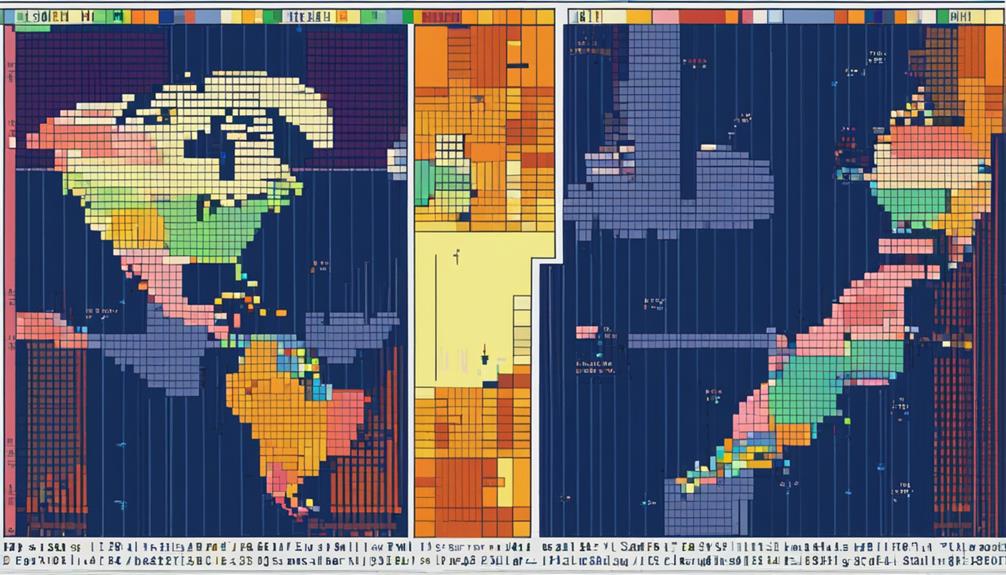Satellite spectrum allocation and management form the backbone of global communication infrastructure, with intricate processes and regulations governing the utilization of radio frequencies for satellite systems. The intricate dance between international coordination, national regulations, and technological advancements shapes the landscape of satellite spectrum governance. From ITU guidelines to WRC decisions, the spectrum allocation sphere is a complex web of policies and strategies that influence how we connect and communicate on a worldwide scale. As we delve deeper into this domain, exploring the nuances of spectrum management reveals a compelling narrative of technological progress, regulatory challenges, and the future of satellite communications.
Key Takeaways
- International harmonization efforts ensure efficient spectrum allocation globally.
- Regulatory bodies like FCC and ITU enforce compliance for interference-free satellite communication.
- Spectrum scarcity challenges require effective sharing arrangements and evolving regulatory frameworks.
- Spectrum engineering practices optimize satellite frequency bands for enhanced communication performance.
Role of ITU in Satellite Spectrum

The International Telecommunication Union (ITU) plays a pivotal role in the allocation and management of satellite spectrum on a global scale to ensure efficient and interference-free utilization. Satellite spectrum, which comprises specific frequency bands crucial for satellite communication, is regulated by the ITU to prevent signal interference and promote the effective use of these valuable resources.
ITU's involvement in satellite spectrum management encompasses the coordination of international efforts to harmonize spectrum allocation for satellite communication. By establishing international standards and guidelines, the ITU facilitates the equitable distribution of satellite spectrum, enabling seamless communication services worldwide. This standardization plays a significant role in promoting interoperability and reducing potential conflicts among different satellite systems operating in close proximity.
The spectrum allocation process overseen by the ITU involves identifying suitable frequency bands for satellite communication, taking into account factors such as propagation characteristics, coverage area, and compatibility with existing systems. Through this meticulous allocation process, the ITU ensures that satellite operators have access to the necessary spectrum resources to deliver their services effectively while minimizing the risk of interference with other communication systems.
International Spectrum Allocation Guidelines
International Spectrum Allocation Guidelines play a crucial role in ensuring global harmonization and efficient use of satellite spectrum. These guidelines, established by the ITU, aim to prevent interference and promote equitable access to the spectrum. By adhering to these international guidelines, countries can foster cooperation and coordination in satellite communication services on a worldwide scale.
Global Spectrum Usage
Facilitating global spectrum usage through adherence to international spectrum allocation guidelines is essential for ensuring efficient satellite communication and avoiding interference. International spectrum allocations by the ITU enable the efficient use of frequencies for satellite communication, while the ITU-R sector manages the global radio-frequency spectrum to avoid interference and ensure equitable access. Satellite spectrum allocation guidelines play a crucial role in regulating frequency usage across borders and continents. Harmonized international bands for satellites are vital for seamless global communication and satellite governance.
- Global harmonization standards ensure smooth satellite operations worldwide.
- Equitable access to spectrum promotes fair competition and innovation in satellite technology.
- Adherence to international guidelines fosters cooperation among nations for effective spectrum management.
- Seamless global communication hinges on the coordination of satellite spectrum usage internationally.
Harmonization Efforts
Harmonization efforts for satellite spectrum allocation focus on coordinating frequency bands globally to ensure efficient utilization and minimize interference in satellite communication systems. International standards and regulations play a crucial role in these efforts, aiming to harmonize spectrum allocation for satellite services. By aligning frequency bands internationally, harmonization efforts promote seamless communication across borders and regions, enhancing interoperability among satellite systems. The International Telecommunication Union (ITU) plays a pivotal role in establishing and implementing agreements to harmonize satellite spectrum allocation globally. This coordination supports the growth and expansion of satellite services by ensuring consistent and compatible frequency usage.
| International Standards | Satellite Services | Harmonization Efforts |
|---|---|---|
| Promote interoperability | Enhance communication | Coordinate frequency bands |
| Ensure efficient utilization | Facilitate growth | Minimize interference |
| Align frequency bands globally | Support expansion | Establish agreements |
| Enhance consistency | Enable seamless communication | Implement regulations |
| ITU involvement | Cross-border communication | Global spectrum coordination |
National Regulations for Spectrum Management

National regulations for spectrum management in the United States are essential for dividing responsibilities between the Federal Communications Commission (FCC) and the National Telecommunications and Information Administration (NTIA) based on non-Federal and Federal spectrum, respectively. This division ensures efficient allocation and use of the radio spectrum. Key points regarding national regulations for spectrum management in the US:
- The Office of Engineering and Technology (OET) within the FCC advises on technical and policy matters related to spectrum management, ensuring informed decision-making.
- The FCC maintains the Table of Frequency Allocations, outlined in Section 2.106 of its Rules, covering frequencies from 9 kHz to 275 GHz, crucial for international and US spectrum planning.
- The FCC's Online Table of Frequency Allocations, regularly updated, serves as a valuable resource for stakeholders to stay abreast of spectrum allocations, supporting transparency and accessibility.
- NTIA complements the FCC's role by providing detailed narratives on Federal spectrum uses, enhancing coordination and coherence in managing spectrum resources across non-Federal and Federal domains.
These regulations and structures are fundamental in ensuring effective spectrum management, promoting innovation, and addressing the growing demands for wireless services in the United States.
ITU's Plenipotentiary Conference Impact
The ITU's Plenipotentiary Conference plays a pivotal role in shaping global policies for satellite spectrum management. Through this conference, ITU member states address critical issues such as spectrum allocation, interference mitigation, and ensuring equitable access to satellite resources. The outcomes of the Plenipotentiary Conference have a far-reaching impact on ITU policies, efforts for global harmonization, and addressing challenges within the satellite industry.
ITU Policies on Spectrum
At the intersection of global satellite communication regulations lies a critical juncture shaped by the policies and decisions formulated at the ITU's Plenipotentiary Conference every four years. These policies from the conference have a substantial impact on satellite spectrum allocation and global regulations. The decisions made at the Plenipotentiary Conference play a pivotal role in shaping the framework for satellite spectrum management worldwide. They directly influence how satellite frequencies are allocated and utilized, setting standards for international satellite spectrum coordination. The ITU's Plenipotentiary Conference acts as a cornerstone for maintaining order and efficiency in the allocation of satellite spectrum resources, ensuring the smooth functioning of global satellite communication networks.
Global Harmonization Efforts
Global efforts towards harmonization in satellite spectrum allocation and management are significantly influenced by the decisions made at the ITU's Plenipotentiary Conference, shaping international coordination and regulatory frameworks. The conference serves as a platform to address crucial issues such as spectrum scarcity, interference mitigation, and ensuring fair and equitable access to spectrum resources. Through the framework established by the ITU, countries are guided in implementing standardized procedures for satellite spectrum management, promoting consistency and efficiency in the global satellite industry. The outcomes of the ITU's Plenipotentiary Conference play a pivotal role in steering the future of satellite communications by defining strategic spectrum allocation strategies that aim to optimize the utilization of limited resources and foster cooperation among nations in managing the increasingly valuable satellite spectrum.
Satellite Industry Challenges
Navigating the complexities of satellite industry challenges requires a deep understanding of the impact of the ITU's Plenipotentiary Conference on global policies and regulations for satellite spectrum allocation.
Key Challenges in the Satellite Industry:
- Spectrum Scarcity: Increasing demand for spectrum resources poses challenges for satellite operators in securing adequate frequencies.
- Interference Mitigation: Ensuring interference-free operations amidst crowded spectrum environments is a significant challenge.
- Efficient Spectrum Management: Optimizing the use of allocated spectrum bands is crucial for maximizing operational efficiency.
- Adherence to Global Policies: Compliance with international regulations and standards set by the ITU is essential for harmonious satellite operations on a global scale.
Addressing these challenges requires proactive engagement with regulatory bodies and a coordinated approach to spectrum allocation and management.
Spectrum Allocation Process Overview
How does the spectrum allocation process for satellite communication systems ensure efficient and effective use of radio frequencies? Satellite spectrum allocation is a crucial process that involves assigning specific frequency bands to satellite communication systems to facilitate reliable and interference-free operations. The International Telecommunication Union (ITU) plays a significant role in coordinating global spectrum allocation for satellite use, ensuring harmonization and compatibility among different satellite systems worldwide. Spectrum allocation decisions are made based on technical requirements, interference considerations, and adherence to international agreements to optimize the use of radio frequencies effectively.
The spectrum allocation process for satellite communication systems encompasses several key aspects, including licensing, frequency coordination, and compliance with regulatory standards. Licensing involves obtaining the necessary authorization to operate within allocated frequency bands, ensuring that satellite systems meet specific requirements for spectrum usage. Frequency coordination is essential to prevent interference between different satellite networks operating in adjacent frequency bands, thus maintaining the quality and reliability of satellite communication services. Compliance with regulatory standards ensures that satellite systems adhere to established guidelines and norms set forth by regulatory bodies to promote fair competition and efficient spectrum utilization.
FCC's Role in Spectrum Authorization

The oversight of radio spectrum allocation for non-Federal entities in the United States falls under the jurisdiction of the Federal Communications Commission (FCC), highlighting its pivotal role in authorizing and regulating spectrum usage. The FCC plays a crucial role in ensuring the efficient and interference-free utilization of radio frequency spectrum by implementing a structured spectrum authorization process. Here are four key points highlighting the importance of the FCC in spectrum authorization:
- Regulatory Authority: The FCC holds the authority to grant licenses and assign frequencies to non-Federal entities, ensuring that spectrum allocation is done in a manner that promotes effective communication services while minimizing interference.
- Technical Expertise: Through its Office of Engineering and Technology (OET), the FCC leverages technical expertise to make informed decisions regarding spectrum authorization, taking into account factors like spectrum needs and regulatory compliance.
- Spectrum Management: The FCC's spectrum authorization process involves comprehensive analysis of spectrum requirements, coordination of frequency assignments, and enforcement of regulations to optimize the use of radio frequencies.
- Optimizing Communication Services: By overseeing spectrum authorization, the FCC plays a critical role in managing and optimizing the use of radio frequencies, which is essential for the provision of diverse communication services across the nation.
Spectrum Engineering Best Practices
Efficient utilization of satellite spectrum requires meticulous application of spectrum engineering best practices to optimize frequency bands for enhanced communication performance. Spectrum engineering best practices play a crucial role in ensuring satellite communication efficiency by minimizing interference and maximizing signal quality. By employing advanced tools and techniques, engineers can analyze, plan, and manage satellite spectrum allocation effectively. These methodologies are designed to enhance spectrum utilization and increase the capacity of satellite networks.
One key aspect of spectrum engineering best practices is interference mitigation. By carefully planning frequency bands and transmission parameters, engineers can reduce the likelihood of interference from other systems operating in the same or adjacent bands. This interference mitigation strategy is essential for maintaining the quality and reliability of satellite communication links.
Moreover, continuous monitoring and adjustment of spectrum engineering parameters are necessary to ensure optimal satellite performance. By regularly assessing the usage patterns and signal characteristics, engineers can make real-time adjustments to optimize spectrum utilization and address any emerging issues promptly.
Spectrum Compliance Requirements

Satellite spectrum compliance requirements are an essential aspect of ensuring the smooth operation of satellite communication systems. Regulatory spectrum compliance involves adhering to the frequency bands allocated by the ITU to prevent interference with other systems. Monitoring spectrum usage and enforcing compliance rules are crucial steps in maintaining efficient and interference-free satellite communication.
Regulatory Spectrum Compliance
Adherence to regulatory spectrum compliance requirements is essential for satellite operators to ensure efficient and interference-free utilization of allocated frequencies. When it comes to regulatory spectrum compliance, satellite operators must adhere to rules and standards set by national regulatory bodies such as the FCC and NTIA. To maintain compliance, operators need to follow specific technical parameters, licensing conditions, and engage in frequency coordination to uphold order in the shared spectrum. Failure to comply with these requirements can result in penalties, license revocation, or legal actions to safeguard the integrity of communication networks. Continuous monitoring and adjustment of operations are crucial for operators to stay compliant with evolving spectrum regulations and prevent disruptions in communication services.
- Strict adherence to regulatory spectrum compliance is non-negotiable for satellite operators.
- Compliance ensures efficient utilization of radio frequencies.
- Failure to comply can lead to severe consequences.
- Continuous monitoring and adjustment are paramount for regulatory spectrum compliance.
Monitoring Spectrum Usage
Regular and thorough monitoring of spectrum usage is crucial for ensuring compliance with regulations and maximizing the efficient utilization of allocated frequencies. By employing spectrum monitoring tools and techniques, regulatory authorities can track the radio-frequency spectrum's utilization by different entities. These activities help prevent interference, maintain service quality, and identify unauthorized or harmful transmissions that could disrupt communication systems. Spectrum management rules mandate regular monitoring to enforce compliance and address any violations promptly. The data collected from these monitoring endeavors is instrumental in analyzing spectrum usage patterns, optimizing spectrum allocation strategies, and enhancing overall spectrum efficiency. Effective monitoring ensures that the radio-frequency spectrum is utilized in a manner that aligns with regulatory requirements and industry best practices.
Enforcement of Rules
Efficient enforcement of spectrum compliance rules is paramount for ensuring the integrity and reliability of satellite communication systems. When it comes to radio frequencies, spectrum compliance, and enforcement, the following points are crucial:
- Adherence to ITU regulations and national guidelines is mandatory.
- Non-compliance can result in interference with other services and legal repercussions.
- Satellite operators must strictly stay within allocated frequency bands.
- Enforcement methods include monitoring, regulatory audits, and penalties for violations.
Compliance with spectrum rules is essential to uphold the efficient and interference-free operation of satellite communication systems. By enforcing these regulations diligently, the industry can maintain a properly functioning and harmonious spectrum environment for all stakeholders involved.
NASA's Spectrum Management Strategies

Overseeing spectrum management activities within the agency, NASA's Spectrum Certification Office (SCO) plays a crucial role in ensuring compliance with regulations and coordinating with external agencies like FCC and ITU. The SCO is responsible for ensuring that NASA missions adhere to spectrum regulations, and it actively engages in coordination efforts with key external bodies to harmonize spectrum usage. NASA's Spectrum Management Policy is designed to address spectrum planning, allocation, and interference coordination, ensuring that the agency's spectrum needs are met efficiently.
| Aspect | Description | Importance |
|---|---|---|
| Compliance with Regulations | SCO ensures NASA's adherence to spectrum regulations, avoiding interference and ensuring mission success. | High |
| Coordination with External Agencies | Collaboration with FCC and ITU guarantees harmonious spectrum use, benefiting NASA's space exploration missions. | Critical |
| Advocacy in ITU Meetings | Participation in ITU meetings allows NASA to advocate for its spectrum requirements globally, ensuring compliance with international regulations. | Essential |
NASA's spectrum management strategies prioritize the efficient utilization of spectrum resources to support the agency's space exploration missions and scientific research endeavors. By actively engaging with external agencies and participating in international forums like the ITU, NASA ensures that its spectrum needs are met while complying with global regulatory standards.
SFCG's Spectrum Coordination Efforts
SFCG's Spectrum Coordination Efforts encompass a range of initiatives aimed at efficiently managing radio spectrum allocation for satellites. These efforts address challenges related to spectrum sharing and seek to ensure interference-free communication systems. Additionally, SFCG's active participation in international collaborations, such as the ITU, highlights its commitment to harmonizing satellite spectrum use on a global scale.
Sfcg's Coordination Initiatives
Playing a pivotal role in global spectrum management for satellite communication and space exploration, the Space Frequency Coordination Group (SFCG) diligently coordinates frequency allocation initiatives. SFCG's coordination initiatives include:
- Ensuring seamless frequency management for space organizations.
- Guaranteeing efficient spectrum utilization for satellite communication and space exploration.
- Addressing interference challenges to enhance global spectrum coordination.
- Engaging in international platforms like the World Radiocommunication Conference (WRC) to contribute to effective spectrum management.
Through collaboration with entities such as the International Telecommunication Union (ITU) and other stakeholders, SFCG strives to harmonize satellite spectrum allocation on a worldwide scale, fostering advancements in space technology and communication systems.
Spectrum Sharing Challenges
Given the critical importance of spectrum allocation in satellite communication and space exploration, the Space Frequency Coordination Group (SFCG) is actively addressing Spectrum Sharing Challenges to ensure coordinated and interference-free frequency management for space organizations. SFCG's spectrum management efforts focus on preventing interference among satellite systems, particularly crucial for global satellite communication. By coordinating frequencies effectively, SFCG plays a significant role in harmonizing spectrum use, optimizing satellite operations, and enhancing communication reliability worldwide. This interference prevention is essential for the efficient utilization of spectrum and the seamless functioning of satellite services. The table below highlights key aspects of SFCG's Spectrum Sharing Challenges efforts.
| Spectrum Sharing Challenges | SFCG's Actions |
|---|---|
| Interference Prevention | Coordinating frequencies |
| Global Satellite Communication | Ensuring harmonized spectrum use |
| Spectrum Management | Optimizing satellite operations |
International Collaboration Efforts
How does international collaboration enhance spectrum coordination efforts for space organizations? International collaboration plays a crucial role in enhancing spectrum coordination efforts for space organizations such as the Space Frequency Coordination Group (SFCG). The SFCG engages in collaborative efforts worldwide to harmonize frequency bands utilized by satellite systems, promoting efficient and interference-free operation. Through these collaborations, spectrum coordination is improved, leading to optimized satellite operations and enhanced global communication capabilities. The following list highlights the importance of international collaboration in spectrum coordination efforts:
- Facilitates global harmonization of frequency bands.
- Minimizes interference and maximizes spectrum efficiency.
- Enables effective coordination of satellite systems.
- Supports advancements in space-based technologies.
WRC's Role in Spectrum Management
The World Radiocommunication Conference (WRC) assumes a pivotal role in the meticulous management and allocation of radio frequency spectrum for diverse services and applications on a global scale. As the entity responsible for reviewing and revising the international Radio Regulations, the WRC plays a key role in ensuring efficient and interference-free use of the radio spectrum for various communication services, including satellite operations. WRC sessions, which convene representatives from ITU member states, focus on addressing spectrum allocation issues and making critical decisions that influence global spectrum usage and coordination.
—
| WRC Functions | Description |
|---|---|
| Radio Regulations | WRC reviews and revises the international Radio Regulations, which govern the use of radio spectrum. |
| Spectrum Allocation | The WRC allocates radio frequency spectrum for different services and applications worldwide. |
| Decision Making | WRC decisions impact global spectrum usage and coordination, with implications for various technologies. |
—
The decisions made at WRC sessions are crucial for ensuring the effective management and allocation of spectrum resources, which is vital for the operation of satellite communication systems and other wireless technologies. By actively participating in WRC activities, countries can contribute to the harmonization and optimization of the radio frequency spectrum for the benefit of all stakeholders involved in the telecommunications sector.
Spectrum Regulation Challenges

Addressing the complexities of spectrum regulation presents a critical challenge due to the need to ensure equitable access to limited radio frequencies while balancing the diverse requirements of commercial and government entities. In the realm of spectrum regulation, several key challenges arise, underscoring the intricate nature of this field:
- Limited Radio Frequencies: The finite nature of the radio frequency spectrum necessitates careful management to prevent overcrowding and ensure fair distribution among stakeholders.
- Balancing Commercial and Government Needs: Striking a balance between the demands of commercial entities, such as telecom operators, and governmental agencies like defense and public safety, requires nuanced regulatory frameworks.
- Interference Mitigation: Spectrum regulations must address interference issues to maintain the quality and reliability of communication services, safeguarding against disruptions and signal degradation.
- International Coordination: Collaborative efforts in international coordination are paramount to harmonize spectrum regulations across borders, facilitating seamless global communication and minimizing cross-border interference.
In the face of rapid technological advancements and the increasing demand for spectrum to support innovations like 5G networks, the challenges of spectrum regulation continue to evolve, necessitating agile and adaptive regulatory approaches to meet the diverse needs of stakeholders while ensuring efficient spectrum utilization.
Spectrum Efficiency in Satellite Communication
Satellite communication's spectrum efficiency is enhanced through the utilization of state-of-the-art technologies. By employing techniques such as digital transmission, satellites can significantly increase spectrum efficiency by creating multiple communication channels within the same radio frequency band. Additionally, satellites have the capability to reuse frequencies across different orbital positions, allowing for optimized spectrum utilization. This frequency reuse concept is further enhanced through the implementation of spot beams in satellite communication systems, enabling a level of frequency reuse akin to that seen in cellular networks.
Efficient spectrum management is paramount for ensuring reliable satellite access and enabling seamless global communication. By maximizing spectrum efficiency, satellite communication systems can accommodate a broader range of services and users while maintaining high levels of performance. The strategic allocation of radio frequencies and the implementation of advanced technologies play a vital role in achieving optimal spectrum efficiency in satellite communication networks.
Future Challenges in Spectrum Management

To effectively navigate the evolving landscape of spectrum management, industry stakeholders must proactively engage with the challenges posed by emerging technologies such as 5G and IoT. As satellite spectrum management faces the following future challenges:
- Spectrum Sharing Arrangements: Implementing effective spectrum sharing arrangements will be crucial to optimizing spectrum use and accommodating multiple services within the limited frequency range available. This will require innovative solutions to ensure fair and efficient allocation of spectrum resources.
- Balancing Terrestrial and Satellite Systems: Balancing spectrum allocation between terrestrial and satellite systems is essential to prevent interference and maximize the efficient utilization of available frequencies. Finding the right equilibrium between these systems will be a key challenge for spectrum managers.
- Adapting Regulatory Frameworks: Regulatory frameworks must evolve to keep pace with emerging technologies and market dynamics in satellite communications. Ensuring fair competition and fostering innovation will require regulatory bodies to adapt and streamline regulations effectively.
- International Coordination: International coordination and cooperation are vital to harmonize spectrum policies globally and address cross-border interference issues. Collaborative efforts among nations will be necessary to establish cohesive strategies for managing satellite spectrum on a global scale.
Frequently Asked Questions
How Is Satellite Spectrum Allocated?
Spectrum sharing among users involves allocating specific frequencies for varied purposes, necessitating clear licensing requirements to manage usage. International coordination, often through bodies like the ITU, ensures global harmonization of spectrum allocations to prevent interference and facilitate efficient communication. Proper spectrum management is essential for optimizing the utilization of the limited electromagnetic spectrum, ensuring that satellite operations can coexist and thrive in a crowded spectrum environment.
What Is Spectrum and Spectrum Management?
Spectrum encompasses the electromagnetic frequencies vital for communication services, with specialized bands earmarked for diverse functions. Spectrum management involves meticulously planning, coordinating, and regulating radio frequency usage to prevent interference and ensure optimal communication systems. Regulatory frameworks, such as those established by the ITU, govern national and regional authorities like the FCC and CEPT. Spectrum management focuses on enhancing spectrum efficiency by defining usage requirements, assigning frequency bands, and licensing users to support wireless communication technologies.
What Are the Frequency Allocations for Satellite Services?
Frequency allocations for satellite services encompass various bands crucial for satellite communication and broadcasting. These bands include S-DAB, L-BAND, S-BAND, C-BAND, and Ku-BAND, each with specific frequency ranges like 1.467 GHz to 1.497 GHz for S-DAB and 10.7 GHz to 14.5 GHz for Ku-BAND. These allocations ensure efficient bandwidth allocation for satellite operations, facilitating reliable communication and broadcasting services.
What Is the Allocation of the Radio Spectrum?
The allocation of the radio spectrum involves assigning specific frequency bands to different users and services to ensure efficient spectrum utilization. This process is governed by a regulatory framework that includes international coordination efforts to optimize spectrum efficiency. Spectrum sharing mechanisms and interference mitigation strategies are key components of spectrum allocation to accommodate the diverse needs of users and prevent signal disruptions. Efficient spectrum allocation is crucial for meeting the increasing demand for wireless communication services.
